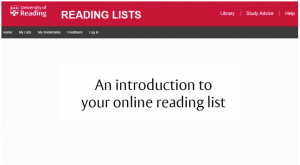One of the first things that we will send you before your course starts is a reading list, so we thought this might be a good chance to say something about what a reading list is for.
The reading list helps you make the best use of our learning resources in a way that is tailored to your modules. For your first term, you may get this reading list in paper copy, but for the rest of your degree you will be able to access it electronically on our VLE. We will explain how to access the VLE and use the library’s online systems in Welcome Week.
Your reading lists will be divided into sections: there will be an ‘essential reading’ or ‘set texts’ section that will list the books that you will be studying on the module (a textbook, an anthology, or a short list of book or film titles). A few of these will be listed as ‘recommended for student purchase’. It is a good idea to buy copies of those, because you will be using them intensively on the module. It’s also a good idea to buy the edition we recommend. (This means buying a copy published in the same year and with the same ‘ISBN’ number: the ISBN is a 10 or 13 digit number that identifies a book.) We try to recommend editions that give you the most up-to-date information. There will always be at least one copy of these books in the library, but it will be in high demand. Watch out for second –hand copies for sale in the bookshop on campus!
The rest of your reading list will be longer than the ‘essential reading’. This is what we often call ‘secondary reading’. Anything listed as ‘secondary reading’ or ‘general reading’ is not a book you need to buy: there will be a copy in the library, either in paper form or electronically. We don’t actually expect you to read all of the texts that we list in this section! Secondary reading is to help you with the topics that you’ve decided to research for essays or other assignments. This reading supports your ‘essential’ reading with more detailed analysis. The list might include links to web resources as well as the names of books that you can find in the library or journal articles and essays that you can access electronically. So the ‘secondary reading’ list contains lots of very detailed scholarship on a whole range of topics: your job (once you start researching your assignment) is to choose which items on that list are most useful to the topic you are working on.
Your seminar leaders will give you advice on how best to tackle your reading, but don’t be afraid to ask for help if you feel unsure. The reading list is a key component of university study, and there is an art to using it well!


